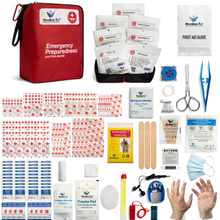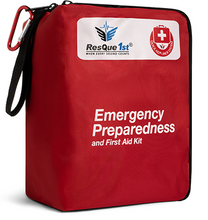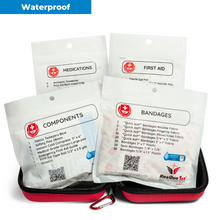
If you've ever put together a first aid kit, you've probably spent a lot of time thinking about what goes into it. But it can be just as important to consider your first aid kit container. The container you choose to house your first aid kit will have an impact on how, where, and when you can use your kit. There are pros and cons to any of the containers you choose. Read on to learn a few of them.
First Aid Kit Basics: Container Pros and Cons
Plastic First Aid Containers: You may choose to keep your first aid kit in a plastic container. This is a classic choice, and is often used for pre-made kits. Plastic cases are inexpensive, durable, and give you lots of space. Depending on its size, you may find that a plastic container is not particularly portable. This makes it a good choice for use in the home or in small workspaces.
Metal First Aid Containers: Metal first aid kits give your contents added protection against the elements. Because they're waterproof, they're a great choice for outdoor situations. The downside is they are quite heavy, which reduces their portability. Metal containers make sense for outdoor work sites, as well as situations where your kit may encounter heavy use.
Cloth Bag: A cloth first aid container usually features many zippers, pockets, and compartments. This can be a great way to keep your contents organized. They usually feature a handle or strap, which increases their portability. The downside to cloth containers is their lack of durability. We recommend saving cloth containers to low use situations, such as a car kit.
Backpack: A backpack first aid kit builds upon the benefits of the cloth kit, providing plenty of organizational options with superior portability. It's easy to sling a backpack on your back and hit the trail with what you need. Again, the downside of this type of kit is durability. It's a good idea to use this container for situations where you'll be on the go, and avoid using it in heavy use areas.
Makeshift First Aid Containers: It's not always necessary to purchase a separate container for your first aid supplies. If you're creating a kit for a very specific low use situation, makeshift containers can work just as well, or even better. Food storage containers give you a small, sturdy, weather-proof space for a few supplies. Ziploc bags are lightweight, waterproof, and easy to fill with what you need - perfect for hiking. Waist pouches can be a smaller alternative to cloth bags and backpacks, while a plastic storage bin gives you a large, durable stand in for a plastic or metal container.
The right container can make a big difference in how safe and accessible your first aid supplies are. Don't be afraid to get creative, but do make sure the container you choose is right for your situation.









